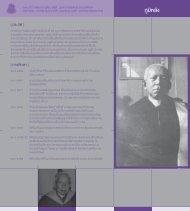Create successful ePaper yourself
Turn your PDF publications into a flip-book with our unique Google optimized e-Paper software.
2Dy-LiaccoI make use of this point in the analysis of Roman imperial coins in relationto the Book of Revelation. The second concept comes into play when Iconsider how these coins and their usage not only materialised the Romanimperial will and cosmology, but—in a way unintended by the issuingauthorities—became material basis for expression of the Jewish and earlyChristian world views as well.But beyond extending memory, the material extension of cognitionalso plays a profound role in human activity. Referencing MauriceGodelier, Taylor points out that “objects are things without which onecannot actually be a man or a woman, a police officer or a priest…” (Taylor2008:309). In other words, the cognitive value of the material medium goesbeyond the signification of meaning, to the meaning itself. This point hasimplications when considering the significance of texts in relation to theirbeing descriptions of “reality.” In the words of Anders Andrén, “since alloral presentation is linear in both time and space, the text must alsopreserve this linearity….Artifacts, in contrast, are the world…” (Andrén1998:148ff, cited in Taylor 2008:305). In this regard, I show that the Book ofRevelation reflects its material context in ways not yet fully pointed out bystandard historical-critical Biblical studies.In light of all the preceding points, the carefully observed materiallandscape is also part of the material medium that extends humancognition. For example, consider iconic mountains and the human sense ofa “sacred.” In sky-reading traditions—whether of the Mayas or ofAustralian aboriginals—this cognitive extension includes the sky in amaterial way (see Ruggles 2005:esp. 3 in relation to Australian aboriginals).The sun, for example, usually is not thought of as an artefact, structure, ormaterial object of human use. But consider what happens when megalithsor other structures are intentionally aligned with the rising or the setting ofthe sun on certain dates. Take, in particular, the way that the Temple ofKukulkan in Chichen Itza catches the late afternoon sunlight at theequinoxes. As described by Anthony F. Aveni (2001), the monumentalpyramid is aligned in such a way that the optical effect of a slithering orfeathered serpent (a kukulkan) appears stretching down its steps. In thiscase, the fullest understanding of this Maya pyramid is inseparable notonly from an understanding of the Maya feathered serpent, but alsoinseparable from an understanding of the Maya sun – its path through thesky, its changing position on the horizon throughout the year, and its placein the Maya cosmology.This argument for including carefully observed celestial objects in



